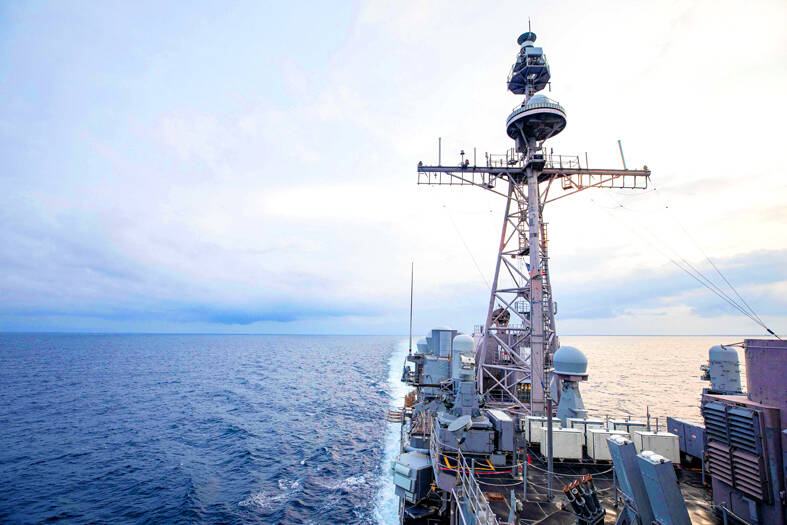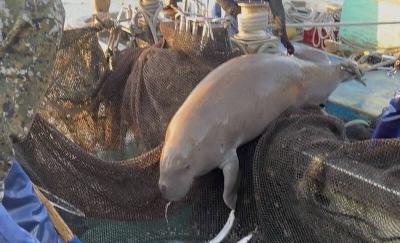A defense expert has called on the US to increase its military presence around Taiwan to deter Chinese military forces from entering the nation’s territorial space.
Huang Chung-ting (黃宗鼎), an associate research fellow at the government-funded Institute for National Defense and Security Research, made the call in an article published on the institute’s Web site on Friday.
Over the past decade, the Chinese People’s Liberation Army (PLA) has been extending its reach across the Taiwan Strait and to the east of Taiwan beyond the first island chain, Huang said in the article, titled “How to avoid war? US military needs to form new norms across the Taiwan Strait.”

Photo: AFP
PLA warships first crossed the median line of the Taiwan Strait in 2014, and by 2016 China began deploying warships around Taiwan and sending planes close to the nation’s air defense identification zone (ADIZ), Huang said.
From 2020 to 2021, the PLA started to ignore the existence of Taiwan’s ADIZ by routinely sending military assets into the southwest and southeast of the zone, he said.
Last year, the PLA began conducting drills and engaging in other military provocations around Taiwan and its outlying islands, in an attempt to constrict the Taiwanese military’s response in the event of a Chinese invasion, Huang said.
The most recent incursions this year by the PLA mean that it is just a matter of time before its forces enter Taiwan’s 24 nautical mile (44.4km) contiguous and 12 nautical mile territorial space, he said.
The military has said that eight PLA aircraft crossed the median line of the Strait on June 22 and 23, and approached the outer boundary of the contiguous zone.
While PLA planes and ships have frequently come near Taiwan, and Chinese aircraft have occasionally crossed the median line, they rarely approach the contiguous zone, which is about 44 nautical miles east of the median line.
The last time PLA warplanes were spotted near the contiguous zone was Dec. 31 last year, when they came within 24 nautical miles of Taiwan’s coastline.
Huang said that if the PLA enters Taiwan’s territorial space, the military would be forced to take defensive action against Chinese warships or military aircraft, which would inevitably lead to a cross-strait war.
As Chinese military forces continue to expand eastward, they would no longer be deterred by regular US patrols and US arms sales to Taiwan, Huang said.
The only way to stop China from altering the cross-strait “status quo” is for the US to significantly increase it military presence around Taiwan — in the air and at sea — to counterbalance the PLA’s increasing military coercion in the region, he said.
The median line of the Taiwan Strait is an unofficial border between Taiwan and China that had been tacitly observed by both sides from the 1950s until last year, when Beijing became enraged by then-US House of Representatives speaker Nancy Pelosi’s visit to Taipei.
An ADIZ is an area declared by a country to allow it to identify, locate and control approaching foreign aircraft, but it is not part of its territorial airspace as defined by international law.

‘DENIAL DEFENSE’: The US would increase its military presence with uncrewed ships, and submarines, while boosting defense in the Indo-Pacific, a Pete Hegseth memo said The US is reorienting its military strategy to focus primarily on deterring a potential Chinese invasion of Taiwan, a memo signed by US Secretary of Defense Pete Hegseth showed. The memo also called on Taiwan to increase its defense spending. The document, known as the “Interim National Defense Strategic Guidance,” was distributed this month and detailed the national defense plans of US President Donald Trump’s administration, an article in the Washington Post said on Saturday. It outlines how the US can prepare for a potential war with China and defend itself from threats in the “near abroad,” including Greenland and the Panama

The High Prosecutors’ Office yesterday withdrew an appeal against the acquittal of a former bank manager 22 years after his death, marking Taiwan’s first instance of prosecutors rendering posthumous justice to a wrongfully convicted defendant. Chu Ching-en (諸慶恩) — formerly a manager at the Taipei branch of BNP Paribas — was in 1999 accused by Weng Mao-chung (翁茂鍾), then-president of Chia Her Industrial Co, of forging a request for a fixed deposit of US$10 million by I-Hwa Industrial Co, a subsidiary of Chia Her, which was used as collateral. Chu was ruled not guilty in the first trial, but was found guilty

A wild live dugong was found in Taiwan for the first time in 88 years, after it was accidentally caught by a fisher’s net on Tuesday in Yilan County’s Fenniaolin (粉鳥林). This is the first sighting of the species in Taiwan since 1937, having already been considered “extinct” in the country and considered as “vulnerable” by the International Union for Conservation of Nature. A fisher surnamed Chen (陳) went to Fenniaolin to collect the fish in his netting, but instead caught a 3m long, 500kg dugong. The fisher released the animal back into the wild, not realizing it was an endangered species at

DEADLOCK: As the commission is unable to forum a quorum to review license renewal applications, the channel operators are not at fault and can air past their license date The National Communications Commission (NCC) yesterday said that the Public Television Service (PTS) and 36 other television and radio broadcasters could continue airing, despite the commission’s inability to meet a quorum to review their license renewal applications. The licenses of PTS and the other channels are set to expire between this month and June. The National Communications Commission Organization Act (國家通訊傳播委員會組織法) stipulates that the commission must meet the mandated quorum of four to hold a valid meeting. The seven-member commission currently has only three commissioners. “We have informed the channel operators of the progress we have made in reviewing their license renewal applications, and